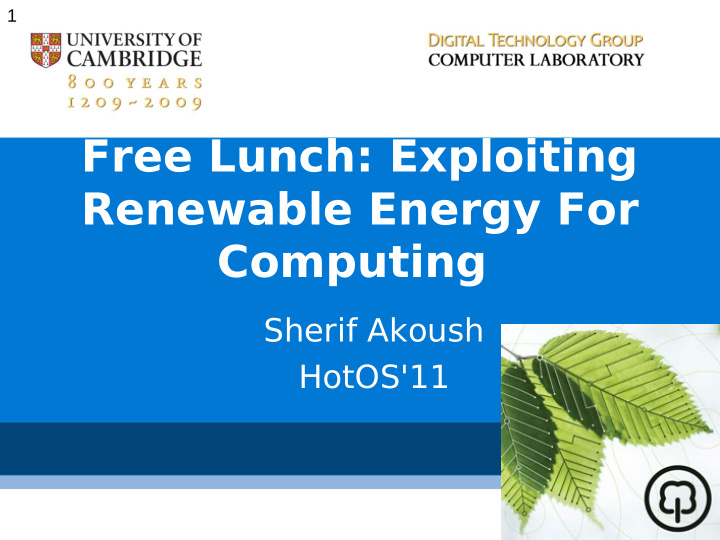



1 Free Lunch: Exploiting Renewable Energy For Computing Sherif Akoush HotOS'11
Greenpeace International http://www.youtube.com/watch?v=QPty-ZLbJt0
Renewable Energy in Computing Datacenterknowledge.com
Renewable Energy Wind+Solar in 2007
Infrastructure Sun Modular Datacentre
Technical Challenges • Predicting VM migration times Predicting the Performance of Virtual Machine Migration , MASCOTS’10 • Storage synchronisation Activity Based Sector Synchronisation: Efficient Transfer of Disk- State For WAN Live Migration , MASCOTS’11 • Scheduling and placement – Stop-Resume vs. migration – Capacity planning (slack reserve) – Energy mix
Case Study
Datacentre Locations Red Sea South East Australia
Impact on Availability (for one VM) • VM downtime due to memory + disk: ≈ 0.5 seconds (10 Gbps link) • 615 migrations per year x Downtime: ≈ 415 seconds • 99.95% SLA: 15,768 seconds allowed < 3%
Energy Consumed (for one VM) • VM Parameters – Memory: 7.5 GB – Disk: 20 GB (modified) • Network – Network: 10 hops – Cisco CRS-1: 3 nJ/bit • Total energy per migration: 57.5 kJ ≈ 0.5 cup of tea
Conclusion • Exploit remote renewable that is otherwise lost • Migrate workloads according to power availability • Transition cost (energy/time) is minimal • Future work – Workload suitability – Slack reserve – Cost model
• Thanks to: Ripduman Sohan, Bogdan Roman, Andy Rice, Andrew Moore and Andy Hopper DATACENTRES WORKLOAD TRACES PLEASE
Predicting (Memory-state) Migration Times MASCOTS'10
Storage Synchronisation (Activity-based) • Synchronise disk-state while the VM is running at the source • Write rate is relatively low (compared to network speed) • A few sectors are written many times (for Microsoft production workloads) • Bandwidth vs. latency • Adaptive at the sector level – Retain hot sectors – Transfer cold sectors MASCOTS'11
Recommend
More recommend